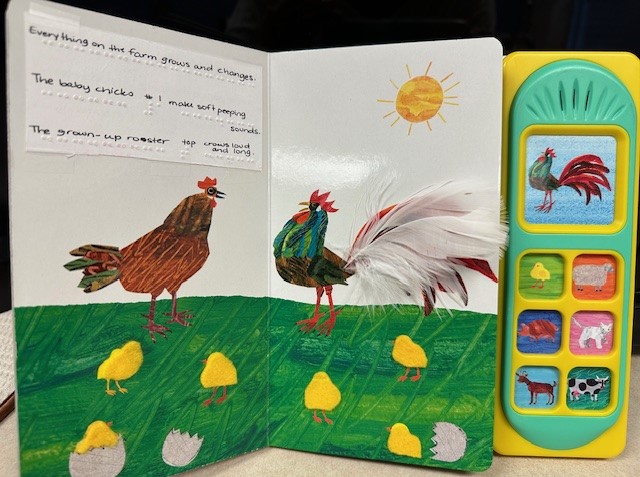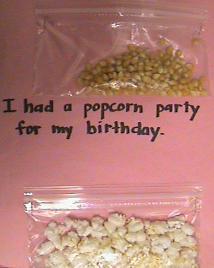Foundational Skills are the beginning processes of reading for students in grades K-5. Foundational Skills facilitate students’ understanding of important beginning reading concepts such as:
- Print concepts
- Phonological awareness
- Phonics and word recognition
- Fluency
In the video below, Anna M. Swenson outlines the building blocks of the reading process. This includes a discussion of the special consideration for braille learners in the standard areas of Print Concepts, Phonological Awareness, Phonics and Word Recognition and Fluency.
These beginning reading concepts are grouped into four standards. As children master these essential reading concepts they will become proficient readers (CCSS, 2010, p. 15).
The table below provides a detailed look at the CCSS for Foundational Skills.
| Standard Name | Standard Number | Standard Description |
| Print Concepts | 1. | Demonstrate understanding of the organization and basic features of print. |
| Phonological Awareness | 2. | Demonstrate understanding of spoken words, syllables, and sounds. |
| Phonics and Word Recognition | 3. | Know and apply grade-level phonics and word analysis skills in decoding words. |
| Fluency | 4. | Read with sufficient accuracy and fluency to support comprehension. |
View the complete CCSS Foundational Skills.
Researchers of the Reading Adventure Time iPad App chose the CCSS in Foundational Skills that were most beneficial to students who use braille to increase their braille literacy skills. Therefore, of the four standards listed in Foundational Skills, phonics and word recognition and fluency were the most appropriate standards to include in the Reading Adventure Time iPad App.
Foundational Skills: Phonics and Word Recognition
Phonics is the ability to connect letters of written language to individual sounds in spoken language. Phonics is an essential skill to help students understand the alphabetic principle which is the understanding that words are composed of letters that represent sounds (National Reading Panel, 2001; Rycik, & Rycik, 2007; Strickland, 2011; Adams, 1990). Word recognition is the ability to determine the pronunciation and meaning of unfamiliar words (Rasinsi & Padak, 2001; Rycik, & Rycik, 2007). It includes the ability to identify words that have been previously encountered (Wormsly & D’Andrea, 1997). To become proficient readers it is important that students understand the relationship between sounds and letters (Rycik & Rycik, 2007).
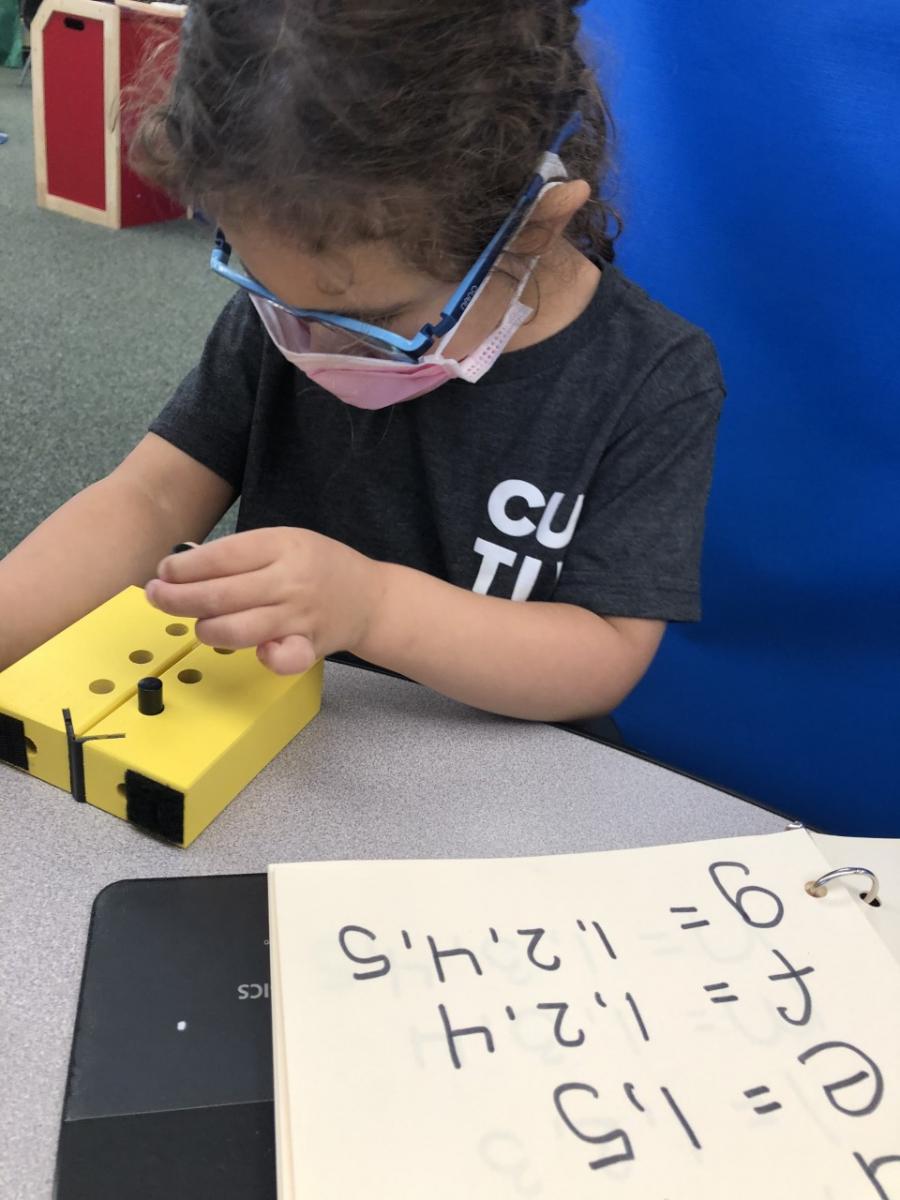
Foundational Skills Phonics and Word Recognition: Impact for Students Who Read Braille
Young children who will be braille readers have very few if any encounters with braille before they enter school. These young children are not exposed to braille as they go about their daily lives. Therefore, when children who will be braille readers begin formal reading instruction they are at a disadvantage when compared with young children who are sighted (Hatton, Erickson, & Brostek-Lee, 2010). Children who are sighted have numerous encounters with print before formal reading instruction begins. These children are afforded many opportunities to engage in incidental encounters with print (e.g., words on cereal boxes, restaurant billboards, stop signs, etc.).
In this video, Anna M. Swenson demonstrates three practical activities for helping braille students acquire foundational skills.
Foundational Skills: Characteristics of Proficient Readers of Phonics and Word Recognition
Proficient readers of Phonics and Word Recognition can quickly and accurately read and identify letters and their corresponding sounds. They apply strategies when reading. They use strategies to decode words. They reread to determine the meaning of unfamiliar words. Proficient readers of Phonics and Word recognition understand that words have a base, prefix, and suffix. They can identify and determine the meaning of common prefixes and suffixes. They apply phonics when reading unfamiliar multisyllabic words.
Foundational Skills: Characteristics of Struggling Readers of Phonics and Word Recognition
Struggling readers of Phonics and Word Recognition have difficulty with letter-sound correspondence. They are not able to quickly and effortlessly decode words. Struggling readers do not understand how to apply strategies when reading words. They may not understand how to apply phonics when reading unknown words. Struggling readers of Phonics and Word Recognition have difficulty blending words. They lack motivation to read and learn new words.
Foundational Skills: Fluency
A fluent reader reads smoothly and expressively with speed and intonation as if he or she were speaking naturally. Reading fluency is essential in literacy development because the reader must possess the ability to accurately and automatically decode words to read sentences in a text (Rasinski, 2006). When the reader does not read fluently the voice does not sound natural. Non fluent reading is slow and choppy. The non-fluent reader tends to read in a monotone voice that lacks expression.
Reading Fluency is closely connected to reading comprehension. As readers are able to easily identify words in a text they can shift their attention from focusing on reading the words to comprehending what the text says.
For students whose primary literacy media is braille, reading fluency is achieved through the use of their hand movement as they read. Fluent braille reading requires students to use their hands in the most efficient way for reading. Researchers have found the most efficient braille reader uses both hands and all four fingers of each hand (Kusajima, 1974; Wormsley & D’Andrea, 1997; Wright, Wormsley, & Kamei-Hannan, 2009).
Foundational Skills Fluency: Impact for Students Who Read Braille
Students who read braille have more braille symbols and rules to learn than students who read print. Therefore, more time and practice in decoding is required for student who read braille. As a result it will take students who read braille longer than students who read print to develop Fluency (Wormsley & D’Andrea, 1997). It is important for all students to be provided with models of proficient readers so that they see examples of how a proficient reader reads. For students who read braille it is important that they be provided with experiences of reading with a proficient braille reader. As the proficient braille reader reads the child’s hands should be in contact with both the braille page and the hands of the proficient braille reader (Koenig & Holbrook, 2000).
Foundational Skills: Characteristics of Proficient Readers of Fluency
Proficient readers of Fluency read words with automaticity, resulting in their ability to comprehend information from the text. Proficient braille readers of Fluency read smoothly and efficiently. The most efficient braille readers lightly touch the braille dots applying little pressure. They will read using a two-hand movement pattern and read with four fingers on the page. Good braille readers will quickly and automatically identify braille characters in a brailled text without confusing letters that are similar to other letters. The proficient braille reader exhibits very few if any of the characteristics of hand movements. They scan a brailled text vertically and horizontally in an efficient manner (Koenig & Holbrook, 2000).
Foundational Skills: Characteristics of Struggling Readers of Reading Fluency
Struggling readers in the area of Reading Fluency make large numbers of decoding errors as they read text, they focus heavily on correctly decoding the words in text which results in their inability to comprehend what they have read. They may be able to read words with automaticity but lack the ability to connect words appropriately and add meaningful expression to their reading (Rasinski, 2006).
Resources
Educational Materials
Expanded Dolch Word Cards: American Printing House for the Blind, catalog # 1-03560-00.
Word PlayHouse: American Printing House for the Blind, catalog #1-03562-00.
Making Words 1st Grade: 100 Hands-On Lessons for Phonemic Awareness, Phonics, and Spelling by Patricia M. Cunningham and Dorothy P. Hall (2009). Pearson Education, Inc. The series of Making Words books includes kindergarten through grade five.
Websites
National Braille Press (NBP) Children’s Book Club
Seedlings Braille Books for Children
Dolly Parton’s Imagination Library
The American Action Fund for Blind Children and Adults
Articles and Books
Adams, M. J. (1990). Beginning to read: Thinking and learning about print. Cambridge MA: The MIT Press.
Hatton, D. D., Erickson, K. A., & Lee, D. B. (2010). Phonological Awareness of Young Children with Visual Impairments. Journal Of Visual Impairment & Blindness, 104(12), 743-752.
Koenig, A. J., & Holbrook, M. (2000). Ensuring High-Quality Instruction for Students in Braille Literacy Programs. Journal Of Visual Impairment & Blindness, 94(11), 677.
Kusajima, T. (1974). Visual reading and braille reading: An experimental investigation of the physiology and psychology of visual and tactual reading. New York: American Foundation for the Blind.
National Reading Panel. (2001). Put Reading First: Kindergarten Through 3 Grade.
Rasinski, T. (2006). Reading fluency instruction: Moving beyond accuracy, automaticity, and prosody. Reading Teacher, 59(7), 704-706. doi:10.1598/RT.59.7.10
Rasinski, T., & Padak, N. (2001). From phonic to fluency: Effective teaching of decoding and reading fluency in the elementary school. New York: Longman.
Rycik, M., & Rycik, J. (2007). Phonics and word identification: Instruction and intervention, K-8. Upper Saddle River, NJ: Pearson.
Strickland, D. (2011). Teaching phonics today: Word study strategies through the grades. Newark, DE: International Reading Association.
Wormsley, D., & D’Andrea, F. M. (1997). Instructional strategies for braille literacy. New York, NY: AFB Press.
Wright, T., Wormsley, D. P., & Kamei-Hannan, C. (2009). Hand Movements and Braille Reading Efficiency: Data from the Alphabetic Braille and Contracted Braille Study. Journal Of Visual Impairment & Blindness, 103(10), 649-661.
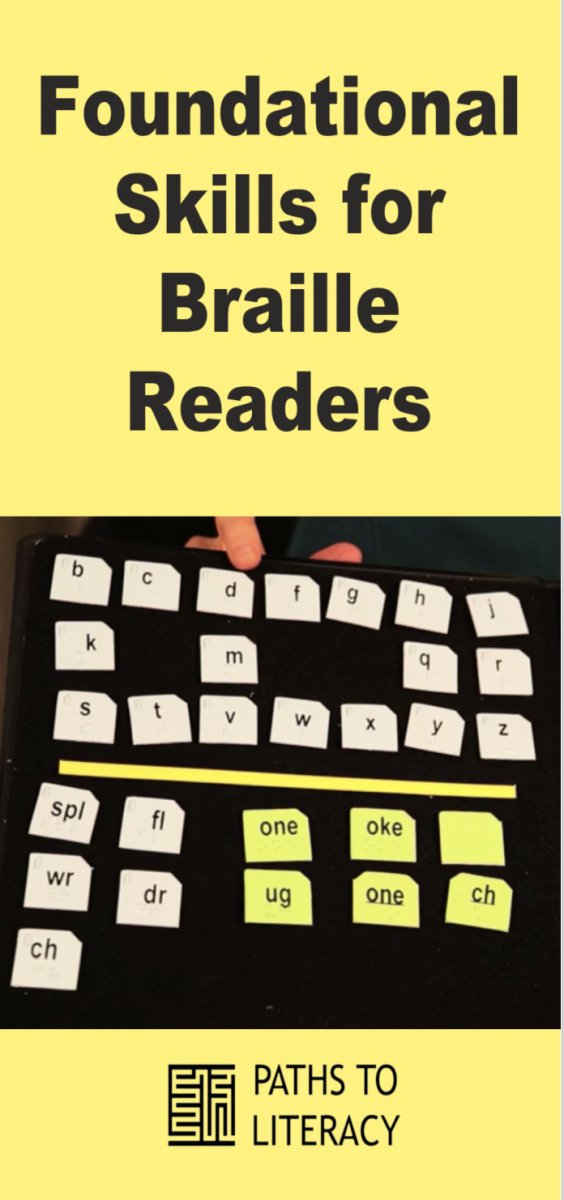
This project was funded by the US Department of Education, Rehabilitation Services Administration (RSA), 84.235E Special Projects and Demonstrations for Providing Vocational Rehabilitation Services to Individuals with Severe Disabilities. The project is titled: Braille Brain: A Braille Training Program for pre/in-service Teachers of Students with Visual Impairments (TSVI), paraprofessionals, and other educational team members (H235E190002).
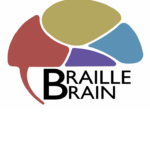
Braille Brain
Reading
- READING: Foundational Skills for Reading
- Integration of Knowledge and Ideas
- Vocabulary Acquisition and Use
- Braille Hand Movement and Refreshable Braille Displays
- Conventions of Standard English: Standard One
- Conventions of Standard English: Standard Two
- Writing and Language
- Craft and Structure
- Key Ideas and Details
- Best Practices for Teaching Braille and STEM to the Visually Impaired
- Assistive Technology to Support STEM Subjects for the Visually Impaired
- Compensatory Skills: A Focus on Organization
- Foundational Skills for STEM
- Math Instruction for Students with Visual Impairments
- Science Instruction for Students with Visual Impairments
- Tactile Graphics
STEM
- Best Practices for Teaching Braille and STEM to the Visually Impaired
- Assistive Technology to Support STEM Subjects for the Visually Impaired
- Compensatory Skills: A Focus on Organization
- Foundational Skills for STEM
- Math Instruction for Students with Visual Impairments
- Science Instruction for Students with Visual Impairments
- Tactile Graphics
- Braille Brain
- About Braille Brain
- Braille Training Program
- Foundational Skills for Reading
- Integration of Knowledge and Ideas
- Vocabulary Acquisition and Use
- Braille Hand Movement and Refreshable Braille Displays
- Conventions of Standard English: Standard One
- Conventions of Standard English: Standard Two
- Writing and Language
- Craft and Structure
- Key Ideas and Details
- Best Practices for Teaching Braille and STEM to the Visually Impaired
- Assistive Technology to Support STEM Subjects for the Visually Impaired
- Compensatory Skills: A Focus on Organization
- Foundational Skills for STEM
- Math Instruction for Students with Visual Impairments
- Science Instruction for Students with Visual Impairments
- Tactile Graphics

